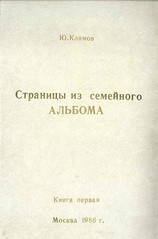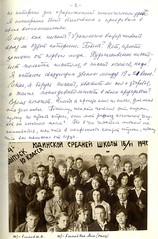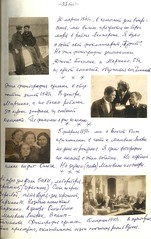Here is the first part that I translated. I desided to start from the chapter where my grandad describes the last part of the ocupation of Odessa and how it was libirated, how he was enlisted into RKKA and later his srvice in Romania and Hungary.
This part of memoirs was writen in 1986
.
- 1 -
10 April 1944 – A sacred day for me and the people of Odessa.
The summer 1942 passed quickly and unremarkably for all the occupants of our apartment. The news from the front that managed to reach us was grievous. German forces had reached the area of the Don River, and were approaching Stalingrad and the North Caucasus area. But Moscow still stood and gave hope to the Soviet people. The German, Austrian and Rumanian press was full of frontline reports proclaiming numerous victories. There were many photo-reports. There was a German magazine “Berliner Illustrated” which was especially known for its glorification of German victories. Looking at its pages I was particularly depressed by the photo-reports showing our POWs: pitiful, exhausted, badly clothed, hungry, ill… But the German troops were always shown fit and healthy, well equipped with automatic weapons, and riding motorcycles or personnel carriers. Everywhere death and destruction, burning towns and villages. The civilians also looked dull and grey. The reporters were clearly determined not to show Russia in the same light as German occupied Europe. All the time the photographs were filled with houses with straw roofs, people dressed in telogreika [a simple bulky overcoat] and ragged foot-wear, women wearing headscarves - such a contrast with the images of French, Belgian, Dutch, Norwegian and even Polish people. Very often and with obvious satisfaction pictures depicted impassable Russian roads: mud up to the wheel axels and on the soldier’s boots up to their knees. They flaunted images of the Russian winter showing their soldiers playing snowballs or football, or taking a snow bath. Also depicted was a panorama of Leningrad (they called it Petersburg) taken through binoculars with a caption proclaiming its imminent capture. The horrors of starvation in Leningrad were vividly presented in order to demonstrate how close the city was to surrender. In the summer of 1942 the main thorn in their side was Sevastopol, which, despite everything, continued to hold out. Can you image - Feodosia, Kerch, Rostov-on-Don, Krasnodar in the German’s hands - but Sevastopol fights on. The people of Odessa knew that their fathers and sons were there somewhere in Sevastopol. [The Soviet troops from Odessa were evacuated to Sevastopol in October 1941]. They were holding Sevastopol as they previously held Odessa. But sad news came in the August when Sevastopol fell… The barges with Soviet POWs started arriving in Odessa. Once I witnessed the passage of a column of our sailors under Rumanian escort. It was already chilly as the autumn kicked in, but some of them were only wearing telniaghka [cotton blouse http://tricotaj.startex.ru/Img/big210.jpg ] and were barefoot. Some had bandages on their heads and hands. A pitiful sight. People who were accidental witnesses to it threw them bread and everything that was immediately to hand (it was near the city’s market – “Privoz”). It seems the POWs were taken to a camp located near the road to Mostdorf at the rope factory. Actually it has to be said of people of Odessa: if they saw POWs, which was frequently, being moved around in work gangs with Rumanian escorts, they engaged in various means to help them with provisions. I myself once had an opportunity to buy them bread and vegetables in the Privoz market in the city. It happened like this: 2-3 trucks with 3-5 people in them drove into the market and stopped in the crowded square. These were some of the camp’s POWs with their escort. People understood right away what was going on and helped as best they could. Bread and Salo [smoked or salted pork fat] and other products were thrown onto the trucks. The guards were indifferent, only concerned that the POWs should not escape. The women were especially generous. With tears in their eyes they did sacred work – saving their brothers, fathers, and husbands from starvation.
In the autumn of 1942 Germans, with they Italian and Rumanian satellites approached Stalingrad. Their armies seized Armavir, Piatigorsk and Nalchik. Their elite mountain troops reached the Caucasus passes and erected the fascist’s swastika on the top of the mountain Elbrus. The upper reaches of the Don and the cities of Voronezh, and Kharkov were under the heel of occupants. The people of blockaded Leningrad were suffering from terrible hunger. The ancient Russian lands of Pskov and Novgorod were in the fascist’s hands. Moscow still stood. The front line ran from Kaluga to Viazma to Gzhatsk. It was close to Moscow and threatening. Seemingly only a miracle could help! But a new Russain winter was coming – our historical ally. Germans, Italians, Rumanians, Spaniards and Hungarians were waiting for it in fear. They had already had the opportunity to experience it in 41-42, though their front position was not bad. Everyday their newspapers listed the tonnage of sunk American and British ships.
There were severe fighting going on in Stalingrad…
But then the attitude of the press radically changed… There were more articles describing troublesome overstretched supply routes, bad roads, and problems with communication lines. Frost descended and the 300,000 strong army led by Paulus was surrounded in Stalingrad. Of course without access to objective information it was difficult to comprehend the futility of their situation, but several soldiers [Rumanian soldiers] that came to “Chervony hutor” [a farm where my grandfather was working at the time and where a small Rumanian regiment was also stationed] told to their “colleagues” how they scarpered through the snowy steppes leaving heavy equipment and weapons behind. These rumours gave us hope and raised our spirits.
Even more, we rejoiced at the three-day long period of mourning for the defeated and captured Sixth Army in Stalingrad.
All through the winter of 42-43 the Germans suffered defeat after defeat at the front. They covered them up with statements about the necessity of shortening the front line - so called elastic defence. But they hoped to engage in a new offensive by the spring of 1943 and restore their gains. Yet it was more and more evident to me that the victory of Fascism had become a historical absurdity and simply not possible. Especially after the way in which Fascism had manifested itself in Russia - after so many innocent victims and so much human suffering. It also became clear that mankind and the Motherland could only be saved through conflict. Germans nervously grasped at any opportunity to increase their power. The traitor General Vlasov organised so called RLA (Russian Liberation Army), which was host to many traitors, cowards and other renegades. But it was all too late. Many millions of people had personally experienced the reality of Fascism – not how it was presented theoretically by the political classes but in practice.
The summer of 1943 had already begun but there was a gloomy calmness at the front. For the Germans this was an unusual situation. They did not hide the fact that a new strike was in preparation. But where? On 5th June 1943 German newspapers reported a new offensive near Belgorod and Kursk and that it was progressing as planned despite the ferocious resistance of the Soviet Army. One week later and the press had turned 180 degrees. They are again in elastic defence. But we already knew what it meant. Liberation of our land had begun en-mass.
7th October – Kiev is liberated. Fighting near Kremenchug and Kirovorgad. Rostov and Taganrog are liberated! The Donbas is liberated. But the Germans stubbornly hold the Don River near Dnepropetrovsk and Nikopol. I and my friends got hold of an old school geography map and every day after work we marked with dots the liberated towns and drew the probable front line. Once I found a partisan leaflet in a field near Mosdorf that contained front line information for November 1943 issued from the Soviet Central Information Bureau. Based on the leaflet we corrected our map.
In December I was chosen together with some other workers on our farm and other nearby villages for work on the ”airfield”, our new officially designated work being 3km away in the direction of the village of “Krivaya balka”. Soon we understood that it was a dummy airfield being built, i.e. its surface did not allow airplanes to land. It was only equipped with the electrical light signals for decoy to attract bombers away from the main airfield. There were about 15 of us and we had to dig a shallow trench for the electrical cable. We were supervised by 5 Germans from the organisation “Orgtodt”. Later we found that they were Austrians from Vienna. Unlike other Germans they were not harsh to us, they treated us well and hated Hitler. One of them once asked me to help him to sell some clothes that he had brought from Vienna. There were 3 shirts, 2 pullovers, 2 pairs of wool gloves and 2 saws, that had obviously come from the German army supplies. On Saturday he and I took tramway and went to the city’s market. We got out at Chumka station and he took me to the barracks where they lived. There was a radio on the table. What a wonderful opportunity! For the first time in 2 years since the war started I could touch a radio. Willy and two others did not have anything against me tuning to the Moscow frequency. I listened to the latest news. What a joy to hear voice of Levitan [the main news announcer on the Moscow radio] communicating the war news. I will never forget that radio news broadcast.
see part 2





